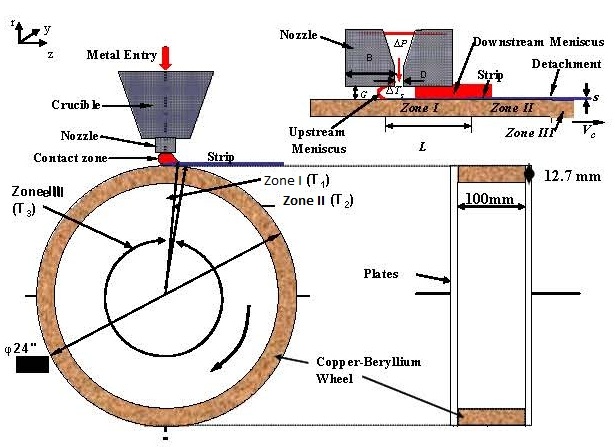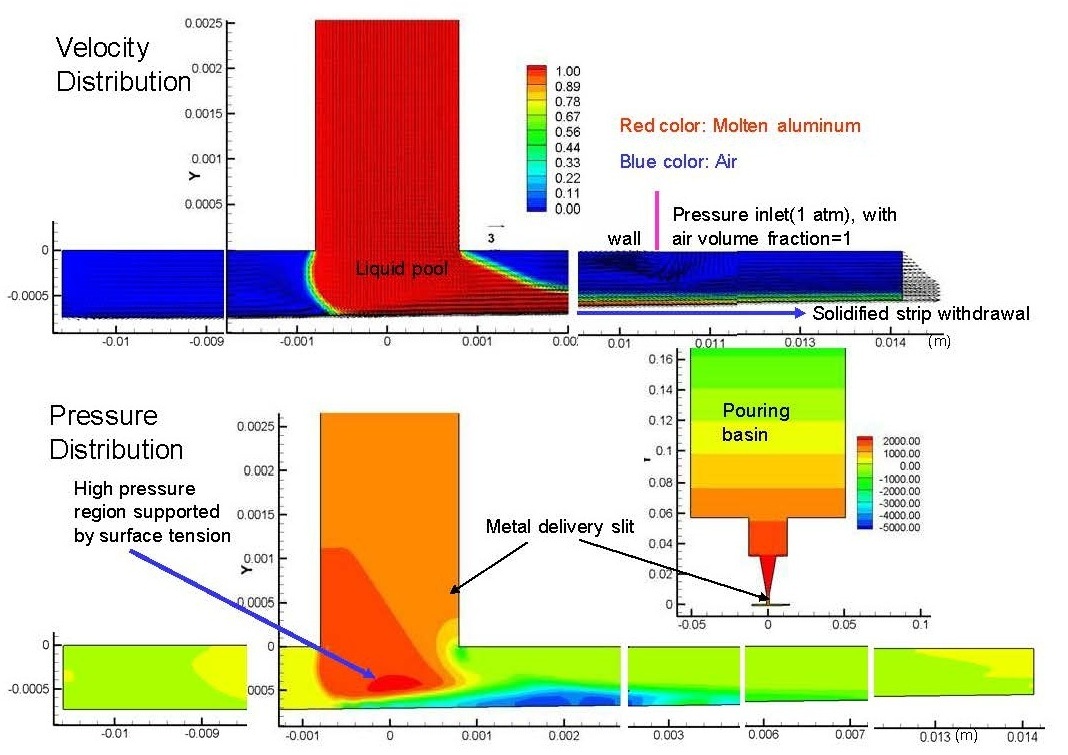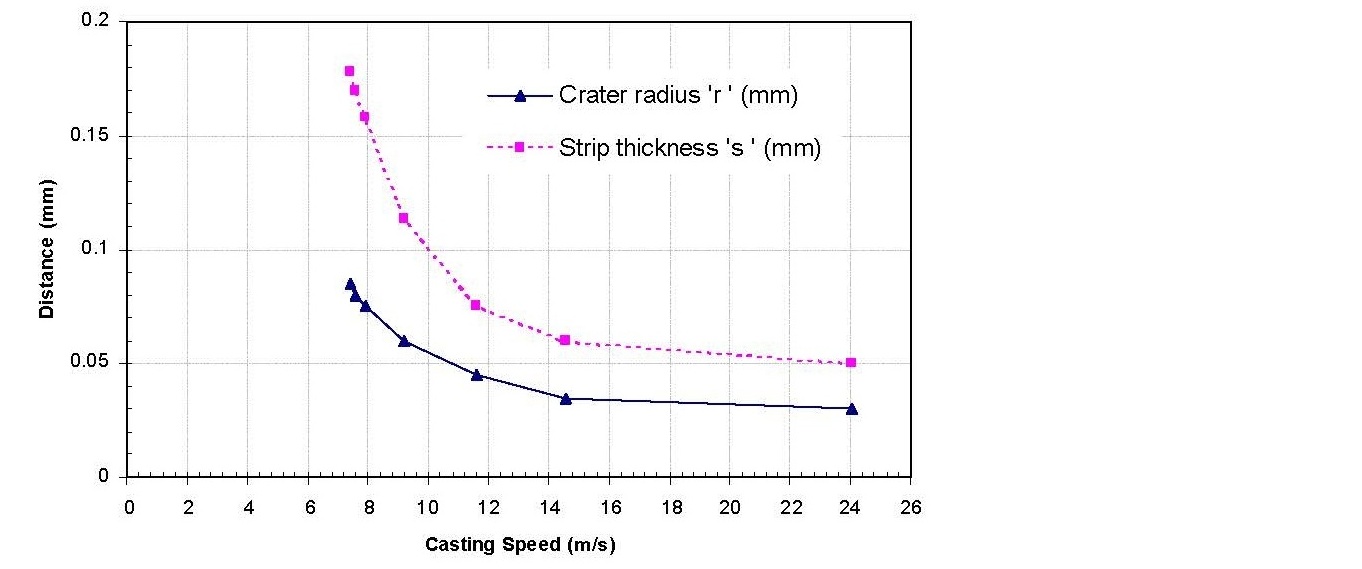(NSF) Collaborative Research: Manipulating the Contacting and Solidification of Molten Metal in Continuous
Casting (2007-2010)
B.G. Thomas, S. Koric, L.C. Hibbeler, A. Sundararajan, R. Chaudhary, V. Singh, R. Liu, O. Debouche, S. Linthout, and O. Albert
Paul Steen, Cornell University INC
National Science Foundation CMMI 07-27620, Continuous Casting Consortium
National Science Foundation Support
CMMI 07-27620
9/15/2007 to 8/30/2010
NSF Program Director: Mary Lynn Realff, (703) 292-0000
NSF Grants Official: Andrea R. Kline, (703) 292-4820
Project Summary
Stress and strain that arise during initial solidification of aluminum and steel is important to the formation of surface defects. Small gaps forming due to gas entrainment or meniscus oscillation generate complex coupling between heat transfer and thermal stress. A fundamental understanding of how key phenomena such as alloying, cooling rate and thermal-mechanical behavior influence this behavior could enable improvements in the control of surface quality. This would make single-wheel strip casting a feasible alternative to other solidification processes. In this project, advanced computational models were developed, evaluated, validated, and applied to study these phenomena, including turbulent fluid flow, heat transfer and pressure drop in the liquid pool, heat transfer and solidification of the strip, and defect formation in the strip shape.
Activities Click Here for a PDF version (12 KB)

The continuous casting of thin aluminum strip with a single-wheel melt spinning process offers great potential for low-cost production of finished products with unique surface textures. To perfect this process requires fundamental understanding of the phenomena which control solidification shape, including flow oscillations in the melt pool, meniscus interaction with the wheel surface, intermittent solidification against the moving wheel, and thermal distortion. This project has supported work on several fronts, including the following 5 computational modeling subprojects, designed to augment the analytical and experimental work that has been conducted at Cornell, and to demonstrate and extend the new computational methodologies developed in this work to other processes:
1) Development of a computational fluid flow model of the molten metal delivery system in the Cornell strip-casting process. Three different undergraduate students, assisted by a senior graduate student, have developed a 3-D finite difference model of fluid flow in the Cornell process using the Volume-of-Fluid method in the CFD package Fluent and applied the model to provide the pressure distribution in the system, as well as the steady-free surface shape.
2) Comparison of computational methods for modeling turbulent fluid flow in molten metal systems, such as the strip caster. The first sub-project identified deficiencies in the ability of standard computational flow models to match the real process. This sub-project was undertaken to evaluate the various models currently available, through comparison with high-fidelity LES and DNS solutions computed for simple flow systems, in order to find the most accurate and efficient methods to model turbulent flow in practical engineering problems. This work is described in a submitted journal paper.
3) Development of a quantitative, computational model of heat transfer and solidification coupled with the transient flow of molten aluminum during the melt spinning of aluminum. Most previous models have coupled fluid flow and solidification together in the same simulation, but this is extremely computationally intensive when done with a mesh that is fine enough to capture the phenomena. In previous work, we developed a method to uncouple the phenomena at the solidification front, by replacing the fluid flow field with an internal source term, but this only works for our in-house code. As part of the current work, we have developed a method to implement this method into the commercial package, ABAQUS, using a user-defined subroutine to incorporate the superheat in with the latent heat. As described in two journal publications, this new multi-physics method has been demonstrated in test problems, and applied to simulate coupled fluid flow, heat transfer, solidification, and stress analysis in a real casting process with complex geometry. It better matches the measured solidification front shape.
4) Development of an efficient thermal-stress model of solidification. This project has involved development of user-defined subroutines to enable the commercial code ABAQUS to simulate realistic highly-nonlinear constitutive behavior using an explicit numerical method, which is more efficient than previous implicit methods. As described in a journal paper, it was first applied to analytical test problems and continuous casting of steel, where previous results was available to validate the new algorithms. It is now ready to apply to other solidification processes, such as the aluminum strip casting process being developed at Cornell.
5) Application of these models to the strip casting process, to test hypotheses and improve understanding of what controls initial solidification at the contacting point between the molten metal meniscus, the rotating substrate (that may contain a “write head” to manipulate it), and the atmosphere. The formation of internal holes in the product have been simulated computationally, by extending the heat conduction method previously developed to model the effect of gaps on the formation of mesa-scale surface depressions in the melt-spun product. Quantitative criteria have been found to predict the onset of hole formation and critical line-defects which can cut the strip product.
Summary of Findings Click Here for the Full Findings PDF (260 KB)
Subproject 1: Simulation of fluid flow and pressure distribution in metal delivery system in single-roll spin-casting of aluminum.
A computational model has been developed of turbulent fluid flow and pressure distribution in the
aluminum strip-casting apparatus at Cornell University. The model solves the Navier Stokes equations using the standard k-e turbulence model in a computational domain that includes the entire metal delivery system, including the puddle region. A special boundary condition at the solidification front enforces mass transfer across the liquid / solid interface according to the strip velocity. Several different models were investigated to handle the free surface of the liquid pool. These included fixed geometry (where the shape of the liquid pool was prescribed) and free-surface model computations, where the shape of the free surface was calculated using the two-phase Volume-of-Fluid method. The latter model included the effects of surface tension, and is the more accurate model. The equations are solved with the commercial package FLUENT on a very fine finite-difference grid which featured 50 cells through the thickness of the puddle. The geometry and casting conditions are for case 43, taken from, and are given in the Findings section. The problem presented computational challenges, including both accuracy and convergence difficulties, which were addressed in sub-project 2.

Velocity and pressure distribution computated in liquid pool of melt-spinning process using computational model of turbulent fluid flow with VOF method, showing calculated shape of liquid puddle, featuring curved surfaces supported by surface tension, and steep pressure gradients in the liquid pool near the accelerating strip.
Subproject 2: Comparison of computational models of turbulent fluid flow.
To address the accuracy problems encountered in subproject 1, a fundamental project to quantify the accuracy of computational models of turbulent fluid flow was undertaken, to find the best computational models for engineering flow problems such as this one. In this work, several low and high Reynolds number versions of k-ε and Reynolds stress turbulence models have been evaluated in a channel and a square duct flow with and without a magnetic field by comparing the predictions with direct numerical simulations data. The simulations are performed using FLUENT solver. The additional source terms for magnetic field effects on turbulence have been included through user-defined functions. A systematic assessment of the predicted mean flow, turbulence quantities, frictional losses and computational costs of the various turbulence models is presented.
Subproject 3: New method to coupled fluid flow and thermal-stress in solidification processes.
A new numerical has been developed to couple the results from a fluid flow analysis into a thermalstress code in order to efficiently simulate the coupled multiphysics of fluid flow, heat transfer, solidification, and thermal stress analysis. The new methodology involves first simulating the fluid flow in a domain that consists only of the liquid pool, using boundaries fixed at the liquidus temperature. The “superheat flux” is extracted at the boundary and is converted to an equivalent latent heat of fusion.
Subproject 4: Explicit Coupled Thermo-Mechanical Finite-Element Model of Steel Solidification.
A new method to simulate thermal-stress evolution has been developed. It is described in a paper that recently appeared in Int. J. Num. Meths. In Eng. which is attached to this report. The explicit finite element method is applied in this work to simulate the coupled and highly-nonlinear thermo-mechanical phenomena that occur during molten metal solidification in continuous casting processes. Variable mass scaling is used to efficiently model these processes in their natural time scale using a Lagrangian formulation. An efficient and robust local-global viscoplastic integration scheme to solve the highly temperature- and rate-dependent elastic-viscoplastic constitutive equations of solidifying steel has been implemented into the commercial software ABAQUS/Explicit using a VUMAT subroutine. The model is first verified with a known semi-analytical solution from Weiner and Boley. It is then applied to simulate temperature and stress development in solidifying shell sections in continuous casting molds using realistic temperature-dependent properties and including the effects of ferrostatic pressure, narrow face taper, and mechanical contact. Example simulations include a fully-coupled thermo-mechanical analysis of a billet casting and thin-slab casting in a funnel mold. Explicit temperature and stress results are compared with the results of an implicit formulation and computing times are benchmarked for different problem sizes and different numbers of processor cores. The explicit formulation exhibits significant advantages for this class of contact-solidification problems, especially with large domains on the latest parallel computing platforms.
Subproject 5: Simulation of Effect of air pockets on pit formation in single-roll spin-casting of aluminum.
The following hypothesis has been developed to explain the observation of holes or pits in the solidified aluminum strip product from the single-roll spin-casting process:
1) Air pockets can be entrapped at the meniscus at the start of the process. These air pockets slow down solidification, due to their low thermal conductivity.
2) This keeps the metal molten in the local region near the bubble during the entire process, even after the surrounding metal has solidified into strip.
3) Due to surface tension of the remaining liquid, a smooth, round hole is formed at the prior location of each air pocket, if it has a critical size to prevent solidification from bridging across the liquid pocket before the strip exits the liquid pool and becomes starved for liquid metal.
A computational model (developed in our previous NSF project) was applied to investigate this hypothesis. Strip solidification has been predicted at different wheel rotation speeds in the presence of air pockets of different sizes. For each rotation speed, the critical sizes of gas pocket that just prevent solidification are extracted from the results. The results seem plausible.

Effect of wheel speed on strip thickness and critical gas pocket size that causes pit formation.
Publications
A. Sundararajan and B.G. Thomas, “Heat Transfer During Melt Spinning of Al-7%Si Alloy on a Cu-Be
Wheel,” Cast Shop Technology, TMS Annual Meeting, Light Metals Proceedings, New Orleans,
Louisiana, 793-810, March 9-13, 2008.Click here for a PDF version (1.29 MB)
A. Sundararajan, "Heat Transfer During Melt Spinning of Al-7%Si Alloy on a Cu-Be Wheel", (2007). Thesis, Published
Bibliography: MS Thesis, University of Illinois, December, 2007
Koric, S., L.C. Hibbeler, and B.G. Thomas, “Explicit Coupled Thermo-Mechanical Finite-Element Model
of Continuous Casting of Steel in Funnel Molds”, Modeling of Casting, Welding and Advanced
Solidification Processes MCWASP XII, Vancouver, Canada, June 7-14, 2009, TMS, Warrendale, PA, 2009. Click here for a PDF version (489 KB)
P.H. Steen and B.G. Thomas, “Collaborative Research: Manipulating the Contact and Solidification of
Molten Metal in Continuous Casting,” Proceedings of 2009 NSF Civil, Mechanical, Manufacturing and
Innovation (CMMI) Engineering Research and Innovation Conference, Honolulu, Hawaii, 3p., Jun. 22-25,
2009. Click here for a PDF version (252 KB)
Koric, S., L.C. Hibbeler, and B.G. Thomas, “Coupled Visco-Plastic Thermo-Mechanical Models of Steel
Solidification”, Plasticity ’09 Conference, St. Thomas, Jan. 3-8, 2009. Click here for a PDF version (691 KB)
Koric, S., L.C. Hibbeler, R. Liu, and B.G. Thomas, “Multiphysics Model of Metal Solidification on the
Continuum Level,” Numerical Heat Transfer, Part B: Fundamentals, 58: 6, 371-392, 2010; DOI:
10.1080/10407790.2011.540954. Click here for a PDF version (1.80 MB)
Koric, S., L.C. Hibbeler, and B.G. Thomas, “Explicit Coupled Thermo-Mechanical Finite Element Model
of Steel Solidification”, Int. J. Num. Meths. Engineering, 78, 1-31, Mar., 2009, DOI: 10.1002/nme.2476 Click here for a PDF version (969 KB)
Chaudhary, R., S.P. Vanka, and B.G. Thomas, “Evaluation of turbulence models in MHD channel and
square duct flows”, CCC Report 201017, Aug. 12, 2010. Click here for a PDF version (1.81 MB) |

